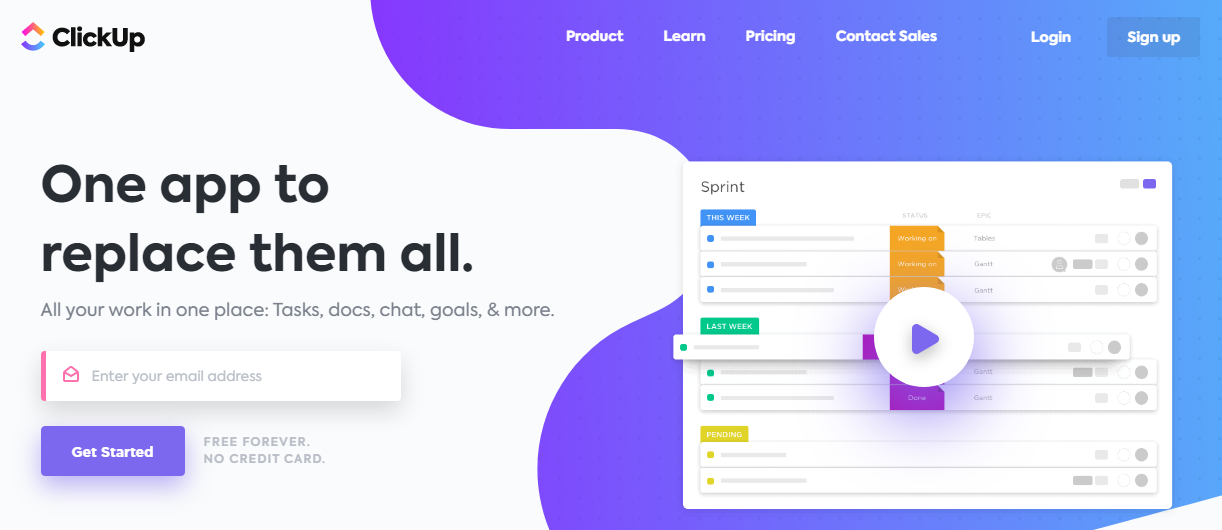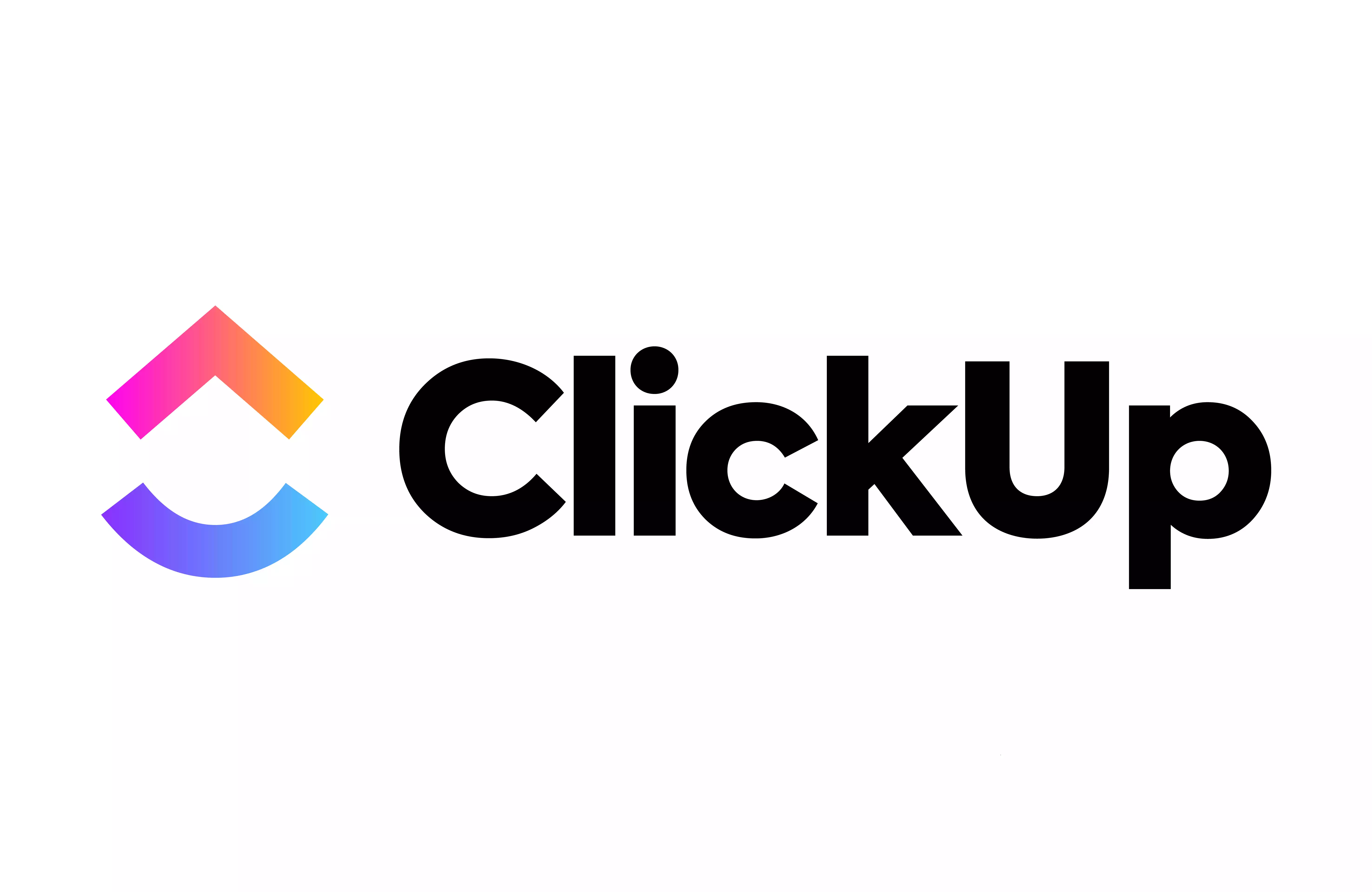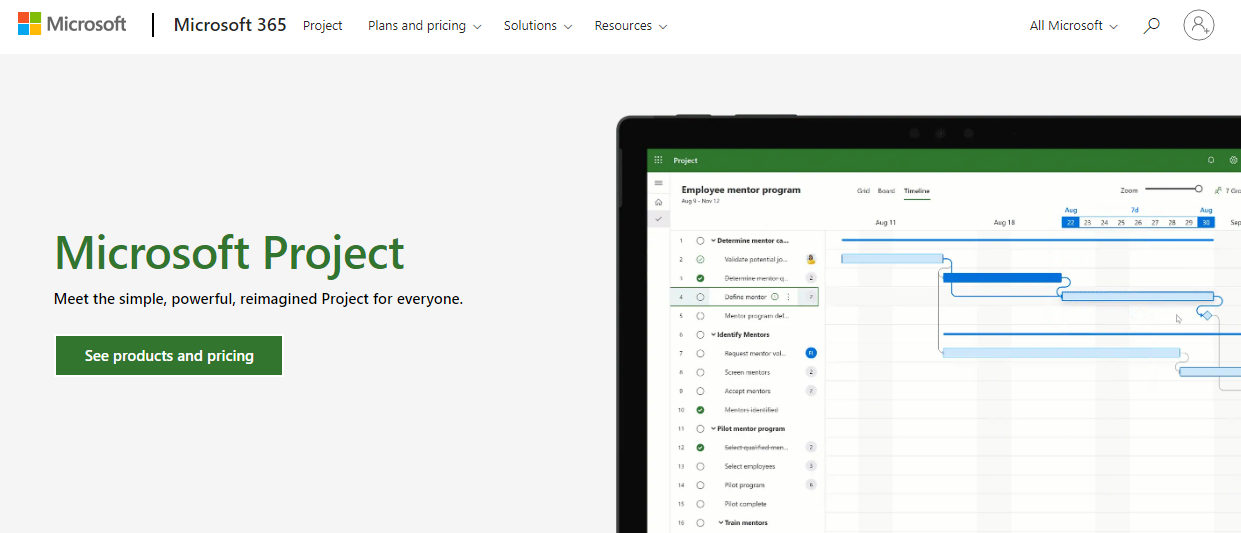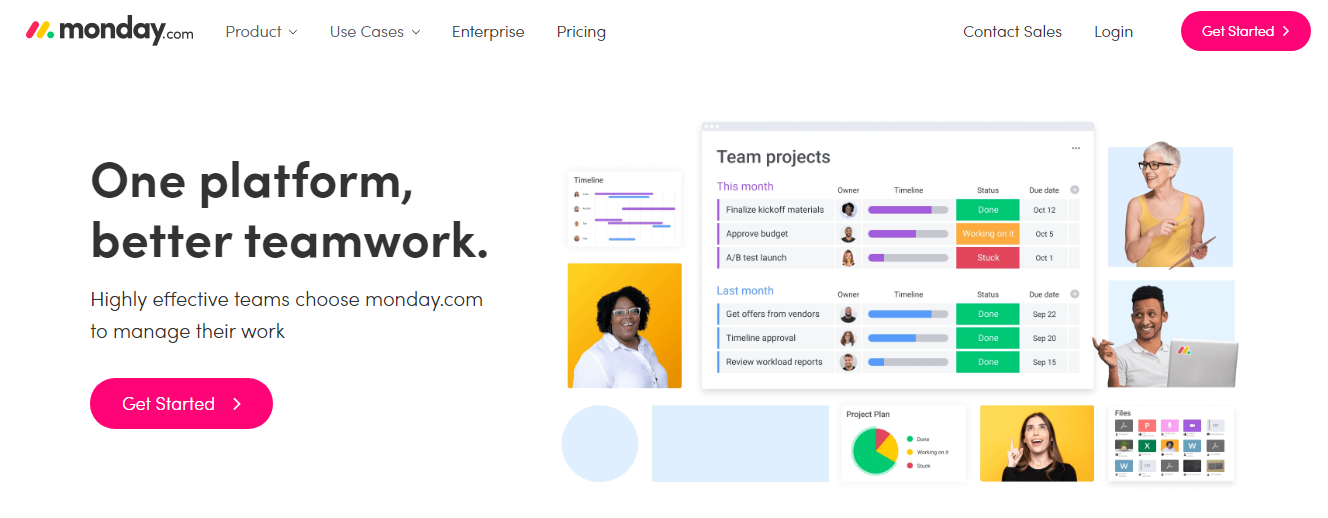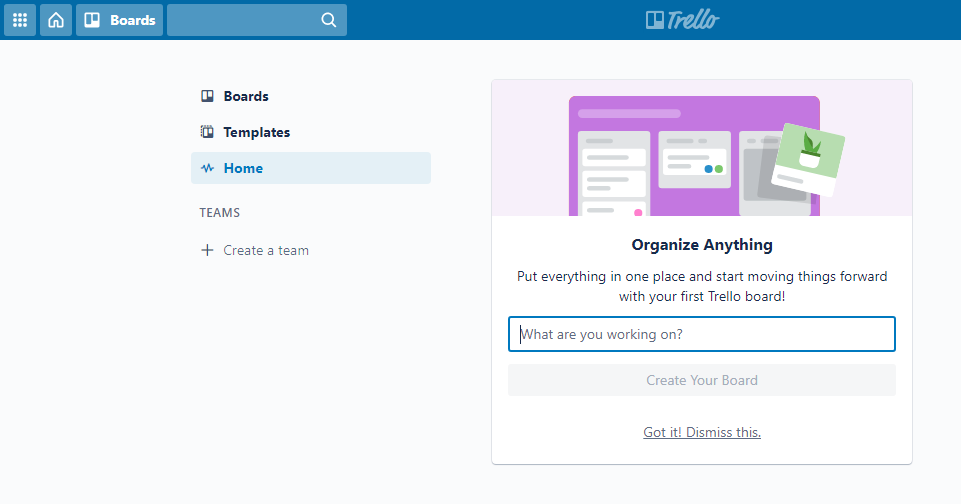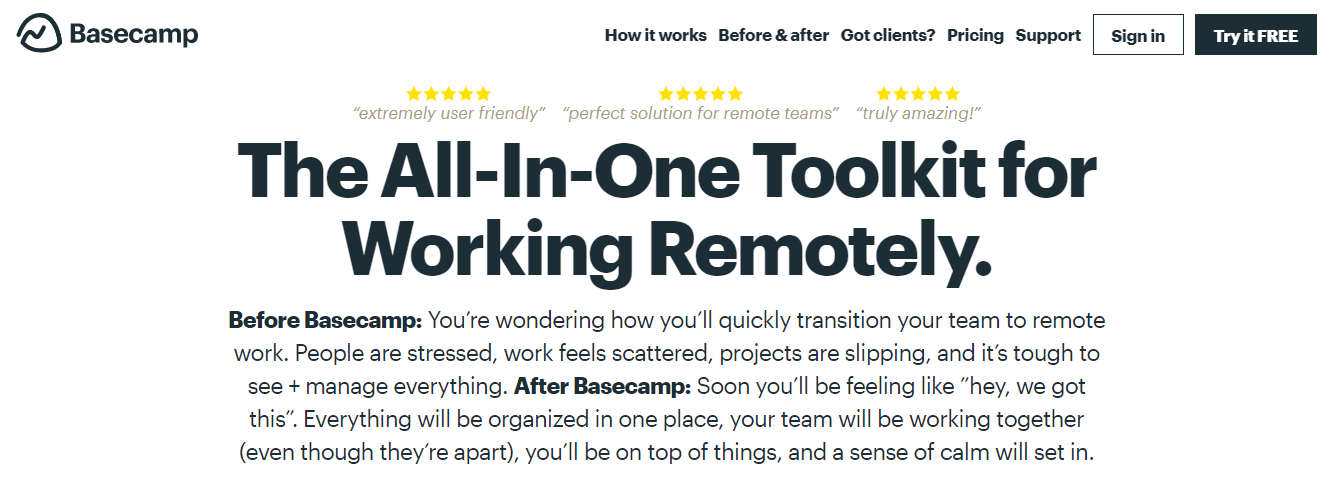Despite Wrike’s global success with over 20,000+ companies in over 140 different countries, the project management software niche has an ever-growing list of competitors. Mainly due in part to businesses needing personalized solutions for their company size, industry, and collaboration style.
Wrike combines an Enterprise-level project and resource management tool. While small to medium businesses can use Wrike, the platform is more aimed at larger, Enterprise-level users.
The platform’s free plan supports small teams of up to 5 users and includes a generous number of features including task management, file sharing, real-time updates, basic integrations, a mobile app, 2 GB of storage, and multiple task management viewing options.
Plus, for under $10 a month, Wrike will throw in Gantt charts, Microsoft Project integration, collaboration tools, and over double the amount of storage space.
The Wrike dashboard uses a 3 pane system which differentiates it from its competitors. The left pane houses resource management including projects, teams, and finances. The center of your screen is a fast track for creating a new task, assigning tasks, and setting deadlines. The right pane lists all of your tasks for quick skimming.
Another benefit of Wrike is its power form builder. A weakness of most of its competitors, Wrike can customize forms according to your specific business needs.
The platform’s request system provides users with automatic task assignments, populates tasks with form information, archive forms, and assigns them to a relevant team member.
Task tracking (task management) can keep a project manager up to date on which projects are active, which team members are working, and when the project will be complete.
Time trackers help encourage maximum productivity, while detailed reporting shows top-performing team members, milestones, and any conflicts that may arise such as past-due deadlines. To keep your projects secure, Wrike offers two-factor authentication support.
Even with all of the benefits, Wrike is not without disadvantages.
Unfortunately, onboarding can be difficult, mobile apps have limited functions, and comments cannot be assigned.
If you are a current Wrike user or are researching project management tools, I’ve provided the 7 best Wrike alternatives below so you can quickly compare how the platform’s competitors stack up.
1. Airtable
Airtable provides a simple to use interface that integrates the best offerings from Google Sheets and Excel to organize lists, entry-level CRM, and manage inventory. It is perfect for users who need inventory tracking and to-lists all in one place.
Pre-made templates for content calendars, project trackers, event planning, and more make onboarding a breeze. Choose from multiple views including the classic spreadsheet, calendar, gallery, and the Kanban tool.
Depending on the plan you choose, you can store files from 2 GB to 1,000 GB which helps you organize attachments on the cloud without paying for an additional service.
To make up for shortcomings in the project management area, Airtable offers integrations to GitHub, WordPress, Slack, and more. Unfortunately, you will have to subscribe to a higher tier plan, making most competitors more affordable to scale.
Pros |
Cons |
|
|
Pricing
- Free trial
- Discount for nonprofits (50% off monthly fee for Pro and Plus plans)
Free Plan
- Unlimited bases
- 1,200 records per base
- 2 GB attachment space per base
- 2 weeks of revision and snapshot history
Plus Plan
($12 per month, $10 per month when paid annually)
- Unlimited bases
- 5,000 records per base
- 5 GB attachment space per base
- 6 months of revision and snapshot history
Pro Plan
$24 per month, $20 per month when paid annually
- Unlimited bases
- 50,000 records per base
- 20 GB attachment space per base
- 1 year of revision and snapshot history
Enterprise Plan
Contact for pricing
- Unlimited bases
- Increased records per base
- 1000 GB attachment space per base
- 3 years of revision and snapshot history
Further Reading on Airtable vs Other Workflow Management Tools:
2. Asana
Asana provides a robust team management solution. All tabs update in real-time including progress view, portfolios, tasks, custom fields, and more. Templates are available to standardize repetitive projects, cutting down planning time for project managers.
Use Asana for complex projects including marketing drip campaigns, light CRM functions, project launches, and eCommerce websites. Individual team members have a clear visual view of task responsibilities and expected deadlines.
Asana is also available in English, French, German, Japanese, Portuguese, and Spanish for ease in global remote working. The platform is used by Disney, NASA, and Spotify.
Pros |
Cons |
|
|
Asana Pricing
- Free trial
- Discount for nonprofits (50% discount for Premium or Business plans)
Basic Plan
FREE
- Unlimited tasks
- Unlimited projects
- Unlimited activity log
- Unlimited file storage (100MB per file)
- Collaborate with up to 15 teammates
- List view projects
- Board view projects
- Calendar view
- Assignee and due dates
- iOS and Android mobile apps
- Time tracking with integrations
- 100+ free integrations with your favorite apps
Premium Plan
$13.49 per month or $10.99 when paid annually
Free plan plus:
- Timeline
- Dashboards (NEW)
- Advanced search & reporting
- Custom fields
- Unlimited free guests
- Forms
- Rules
- Milestones
- Admin Console
- Private teams & projects
Business Plan
$30.49 per month or $24.99 when paid annually
Premium plan plus:
- Portfolios
- Goals
- Workload
- Custom rules builder
- Forms branching & customization
- Approvals
- Proofing
- Lock custom fields
- Advanced integrations with Salesforce, Adobe Creative Cloud, Tableau, Power BI
Enterprise Plan
Contact for pricing
Business Plan plus:
- SAML
- User provisioning & de-provisioning (SCIM)
- Data export & deletion
- Block native integrations
- Custom branding
- Priority support
Further Reading on Asana vs Work Management Systems:
- Asana vs Wrike Compared
- Top Asana Competitors Worth Considering for Work Management
- Asana vs Smartsheet Compared
- Asana vs monday.com Compared
- Asana vs Airtable Compared
- Asana vs Jira Compared
- Asana vs ClickUp Compared
- Asana vs Teamwork Projects Compared
- Asana vs Slack for a Cross Functional Team
3. ClickUp
ClickUp provides task-based management for all types and sizes of businesses. It offers advanced communication and collaboration tools.
You can assign tasks to one or all team members. Comments can be resolved and projects can be viewed as seen in the main dashboard or rearranged according to the team member’s unique working needs.
Easily email a task to ClickUp from Outlook. Using a unique address link for an individual task, simply forward the new task email to the unique address link. Your email instantly becomes a part of the ClickUp task including email contents and attachments.
The ClickUp community can easily submit ideas for improvements to the platform. Each week ClickUp releases upgrades to support its users and their business needs.
Pros |
Cons |
|
|
Pricing
- Free trial
- Negotiated pricing on Unlimited Plan
- Discount for nonprofits (35% off monthly rate)
Free Plan
- 100 MB Storage
- Unlimited Tasks
- Unlimited Users
Unlimited Plan
$9 per month or $5 per month if paid annually
- Unlimited Storage
- Unlimited List, Board, and Calendar views
- Unlimited Integrations
- Unlimited Dashboards
- Guests and Permissions
- Goals, Portfolios, and Custom Fields
Business Plan
$19 per month or $9 per month if paid annually
Unlimited Plus:
- 2FA and Google SSO
- Goal Folders
- Custom Exporting
- Private, Protected, and Default Views
- All Dashboard Widgets
- Extra Guests
- All Automations
- Mind Maps & Timeline Views
- Advanced Time Tracking
- Workload
Enterprise Plan
Contact for pricing
Business Plus:
- Single Sign-On (SSO)
- Contract Review & HIPAA
- Increased API Limits
- Dedicated Success Manager
- Advanced Permissions
- Advanced Workload
- Custom SAML
- Extra Automations
- Custom Onboarding
- Training Program
- White Labeling
I've been so impressed with how quickly ClickUp has caught up with and even EXCEEDED competitors. They have ALL the integrations, plenty of pre-built templates for any use case, AND additional customization for any workflow.
Further Reading on ClickUp vs Other Project Management Software:
- ClickUp vs Wrike Project Management Solution
- ClickUp vs Trello Compared
- ClickUp vs monday.com Compared
- ClickUp vs Notion Compared
- ClickUp vs Teamwork for Small Team Management
- ClickUp vs Asana Project Management Software Tool
4. Microsoft Project
If your business is already using the Microsoft Office suite (MS Project) you may be interested in Microsoft Project.
The platform can add project management capabilities to an already well-known powerful and stable office software.
Main features include a shareable calendar, Gantt charts, resource tracking, and time tracking.
However, the platform is pricey and has a steep learning curve. Microsoft Project is best for large enterprises with healthy budgets. Unlike competitors, to complete your project management tasks you will need to integrate with the whole line of Microsoft software including Microsoft Teams, Excel, Word, Planner, and Outlook.
Pros |
Cons |
|
|
Pricing
- 30-day free trial
- Discount for nonprofits
Project Plan 1
$10 per user per month
- Project Home
- Grid view
- Board view
- Timeline (Gantt) view
- Collaboration and communication
- Co-Authoring
- Project planning and scheduling
- Project for the web app
Project Plan 3
$30.00 per user per month
Plan 1 plus:
- Reporting
- Roadmap
- Timesheet submission
- Resource management
- Desktop client
- Project for the web app
- Project online app
- Project online desktop client app
Project Plan 5
$55.00 per user per month
Plan 3 plus:
- Portfolio selection and optimization
- Demand management
- Enterprise resource
Further Reading on Microsoft Project as a Wrike Alternative:
5. monday.com
Monday.com offers a project management tool with color-coded boards. The boards indicate whether the task is in progress, complete, or if and where any team members are stuck.
Multiple board viewing options include by Date, Person, Status, Text, or Timeline. This is helpful in complex projects to balance out project responsibilities.
Monday.com serves small to large businesses. More notable clients include Adidas, Samsung, and Uber.
Pros |
Cons |
|
|
Pricing
- Free trial
- Free plan for students, faculty, student organizations, and Greek Life
- Discount for nonprofits (yearly plans)
Basic
$29 per month (3 seats minimum, save 18% when paying annually)
- Forms
- Communication with context
- Unlimited free viewers
- iOS and Android apps
- Dashboards
- (1 board per dashboard)
Standard
$36 per month (3 seats minimum, save 18% when paying annually)
Basic features, plus:
- Timeline & Calendar views
- Guest access
- Advanced search
- Automations
- (250 actions per month)
- Integrations
- (250 actions per month)
- Dashboards
- (3 boards per dashboard)
Pro
$59 per month (3 seats minimum, save 18% when paying annually)
Standard features, plus:
- Private boards
- Chart view
- Time tracking
- Formula column
- Automations
- (25,000 actions per month)
- Integrations
- (25,000 actions per month)
- Dashboards
- (10 boards per dashboard)
Enterprise
Contact for pricing
Pro features, plus:
- Enterprise-scale
- Automations & Integrations
- Enterprise-grade security
- & governance
- Advanced reporting
- & analytics
- Multi-level permissions
- Tailored onboarding
- Premium support
- Dashboards
- (50 boards per dashboard)
Further Reading on monday.com vs Other Project Management Software:
- monday.com vs Wrike Compared
- Top monday.com Alternatives Worth Trying
- monday.com vs Basecamp Professional Service
- monday.com vs Slack Compared
- monday.com vs Trello Kanban Board
- monday.com vs Notion Compared
- monday.com vs Zoho Projects
- monday.com vs Jira Complex Project Setups
- monday.com vs Smartsheet Compared
- monday.com vs Airtable Compared
- monday.com vs Hubspot Compared
- monday.com vs ClickUp Compared
- monday.com vs Teamwork Compared
- monday.com vs Salesforce Compared
6. Trello
Trello helps teams keep their projects organized. The platform offers a free version as well as paid Business and Enterprise plans.
Trello is designed to work with boards.
Each board is broken down into lists. Lists have individual cards that incorporate details such as the team member working on the project, custom task checklists, and team collaboration comments.
Labels can be used to improve search capability. Trello is available on any smart device. Changes are recorded in real-time and auto-synced.
Users can purchase Power-Ups to add integrations to the platform that include HR, IT, simple CRM, or marketing.
Pros |
Cons |
|
|
Trello Pricing
- Free Trial
- Discount for nonprofits (75% off Business Class and Enterprise)
- 30% discount for educational institutions
Free Plan Feature Options
- 10 Boards per Team
- Unlimited Cards
- Unlimited Lists
- 10 MB per File Attachment
Business Class Plan Feature Options
- Unlimited Boards per Team
- Unlimited Cards
- Unlimited Lists
- 250 MB per File Attachment
- Advanced Checklists
- Priority Support
- Observers
- Custom Backgrounds & Stickers
- Board Collections
- Team Board Templates
Enterprise Plan Feature Options
- Unlimited Boards per Team
- Unlimited Cards
- Unlimited Lists
- 250 MB per File Attachment
- Advanced Checklists
- Priority Support
- Observers
- Custom Backgrounds & Stickers
- Board Collections
- Team Board Templates
- Additional Admin and Security Features
Further Reading on Trello vs Other Project Management Tool Options:
- Trello vs Wrike Project Management Tool Comparison
- Trello vs ClickUp Compared
- Trello vs Notion Compared
- Trello vs Slack Compared
- Trello vs Favro Compared
- Trello vs Teamwork Compared
7. Basecamp
If you are running a simple website or blog, Basecamp is a good choice for smaller projects. You can track your project and see the progress in real-time, easily communicate with team members, complete group projects, and store any attached documents relevant to the project.
Basecamp has a powerful search function that lets you search across projects, conversations, and more to find what you need quickly without digging through a lot of fluff.
All files are auto-backed up on an hourly basis. Two-factor authentication keeps your account secure.
Basecamp also provides a separate mailbox (Hey! Menu) for all notifications related to your projects and account. You can customize how you receive (and how often) alerts.
Pros |
Cons |
|
|
Pricing
- Free trial
- Free for teachers and students
- Discount for nonprofits (10% off)
Basecamp Personal
Free
- 3 projects
- 20 users
- 1 GB storage space
Basecamp Business
$99 per month (15% discount if paying annually)
- Unlimited projects
- Unlimited users
- 500 GB storage space
- Company HQ
- Team projects
- Unlimited clients
- Advanced client access
- Project templates
- Priority support
Further Reading on Basecamp vs Other PM Tools:
- Basecamp vs Wrike Compared
- Top Basecamp Competitors
- Basecamp vs monday.com Compared
- Basecamp vs Teamwork Compared
- Basecamp vs Slack Compared
8. Other Best Wrike Alternative Options + Runner’s Up
The following are some “other” Wrike alternatives that may be helpful in specific situations.
- Smartsheet: Great for sheet-based tracking and advanced Gantt chart functionality.
- Teamwork: Great if you need something like Wrike, but client focused instead of the large enterprise feel of Wrike.
Best Wrike Alternatives | Frequently Asked Questions
Most Wrike alternatives have an app, including all of the alternatives I have listed in this article (Airtable, Asana, ClickUp, Microsoft Project, monday.com, Trello, and Basecamp.
A Wrike alternative can closely align with your goals or be specific to your industry or team collaboration. Some competitors offer advanced billing and automation services.
Yes. Similar software that offers a free plan includes Airtable, Asana, ClickUp, Trello, and Basecamp.
Yes. Wrike subscribers can find the Outlook integration by locating the Apps & Integrations tab on the Wrike dashboard. In Outlook, go to the add-ins store, search for Wrike, and add it to your navigation bar.
Yes. You can access Wrike from any device using your browser. The desktop app is compatible with Windows, Mac, Android, and Apple.
Conclusion: Wrike Competitors
While all of the 7 alternatives have their pros and cons, it’s important to decide which features you need in a project management software.
Is the visual layout of tasks important? Time-tracking? Level of a learning curve?
Fortunately, all of the alternatives I’ve listed have free trials so you can try before you buy.
Did I list your favorite alternative to Wrike or do you have a different recommendation? Please let me know your thoughts in the comments.
Further Reading on Workflow Management & Collaboration Tool Options:



